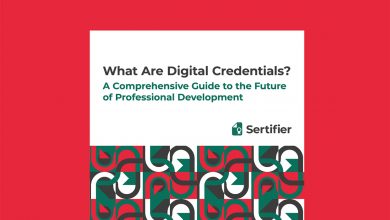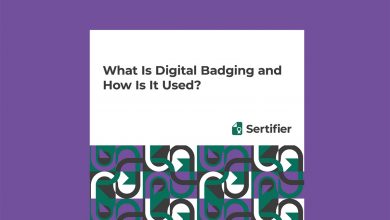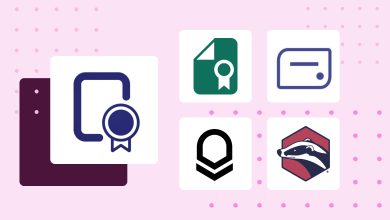Open Badges Explained: Revolutionizing Skills Recognition
Table of Contents
Introduction to Open Badges
Open Badges is a game changer in the realm of skill recognition. These online credentials are changing how we identify and show our talents and successes. In an age where traditional certifications usually fall short of authentically portraying a person’s true talents, Open Badges give a flexible and dynamic alternative. They provide a systematic and accessible method of identifying and certifying skills gained through traditional schooling, online courses, seminars, or practical experience.
This change is centered on digital badges, also known as Open Badges. These badges are visual representations of accomplishments, abilities, and competencies. They are readily shareable and verifiable because they may be earned and posted online. Online badges have evolved into an effective tool for identifying and confirming a wide range of abilities.
This article will explore online badges and investigate their significance, functioning, and impact on lifelong learning, work, and education. Join us on a trip to explore how online badges are changing the norms of talent recognition.
The Significance of Open Badges: Promoting Lifelong Learning and Skill Validation

Open Badges play a considerable role in fostering lifelong learning and recognizing a wide variety of abilities and accomplishments in the current landscape of education and skill validation. To kick off the Open Badges project, Mozilla and the MacArthur Foundation partnered with more than 300 nonprofit organizations, government bodies, and other groups to discuss informal learning, disrupt traditional educational monopolies, and promote personal motivation. These online credentials have a number of significant advantages that add to their importance:
Flexibility and inclusivity
Open Badges are not connected to established educational settings or official degrees. Numerous entities, including universities, online learning platforms, corporations, and even community organizations, are able to issue them. This inclusivity enables students to compile badges from numerous sources and create a thorough portfolio of abilities and successes.
Diverse Skills are Recognized
Unlike traditional degrees or certificates, Open Badges may reflect a broad range of abilities, from technical mastery to soft skills like teamwork or communication. This acknowledgment of various capacities is especially helpful in today’s competitive job market, as employers look for people with a broader range of competencies.
Digital Verification
Open Badges are digital, making it simple to validate and distribute them online. By doing this, the time-consuming and frequently difficult procedure of contacting colleges or businesses to validate qualifications is no longer necessary. Transparency and trust increase since anybody can click on a badge to examine the standards and supporting documentation.
Portability
Open Badges may be shown on a variety of online properties, including digital resumes, personal websites, and LinkedIn. This mobility makes people more visible to prospective employers and business partners by enabling them to demonstrate their abilities and accomplishments to a worldwide audience.
Recognition of Informal Learning
Open Badges reward experience and informal learning in addition to formal schooling. This feature is especially beneficial for people who develop skills through independent study, volunteer work, or freelance labor.
Standardization
Open Badges follow a defined metadata format, ensuring uniformity and comparability among various badge issuers and systems. The legitimacy of badges is increased by this uniformity, and it makes it easier to incorporate them into different educational and job plans.
In conclusion, by providing a flexible, inclusive, and digitally verifiable method of recognizing a variety of talents and accomplishments, Open Badges serve a crucial role in fostering lifelong learning and skill validation. These badges are becoming increasingly critical as the world changes for individuals trying to stay competitive in the job market and businesses trying to discover and develop talent successfully.
How Open Badges Work: Issuing, Earning, and Displaying

In order to make the process open and approachable, Open Badges work on a standardized system for issuing, earning, and displaying online credentials. This procedure may be effectively streamlined using a platform like Sertifier. Open Badges operate as follows:
Authorizes a Badge
The requirements for a particular badge are created and defined by an issuer, which might be any business, including an employer, an educational institution, or an online course provider. This contains any necessary proof or tests and the abilities or accomplishments needed to acquire the badge.
The learner receives the badge
Anyone who satisfies the issuer’s requirements has a chance to obtain the badge. This can be accomplished in a number of ways, for example, by finishing a course, succeeding on a test, or showcasing a particular ability.
The badge is Given
A learner receives the badge when they satisfy the requirements. This procedure may be automated through the badge platform, providing prompt and precise accomplishment acknowledgment.
Displayed and Distributed Badge
Where the badge is displayed is up to the badge holder. To do this, they frequently post it to their online accounts, such as LinkedIn or a personal website. Clicking on the badge will allow you to access the information, which will show you the achieved achievement’s legitimacy.
Validation and Verification
Anyone, including future employers or partners, may click on the badge to confirm its legitimacy. The badge’s information encoding guarantees that it can be easily verified, lowering the possibility of false claims.
Making a Portfolio of Badges
Over time, people can accumulate several badges from various issuers, building up a thorough portfolio of their qualifications and accomplishments. Their credentials and talents are dynamically shown in this portfolio.
Development of Lifelong Learning and Skills
Continuous learning and skill improvement are encouraged through Open Badges. Individuals can earn more badges to show their growing expertise as they gain new abilities or accomplishments.
In conclusion, Open Badges function by offering a standardized and organized method for issuing, earning, and displaying online credentials. This process is made more accessible by platforms like Sertifier, which lets businesses develop and distribute badges, learners acquire and show them, and stakeholders confirm their legitimacy. This method gives people the power to successfully demonstrate their abilities and accomplishments, promoting a culture of talent recognition and lifelong learning.
Employability and Open Badges: How They Enhance Career Prospects

By bridging the gap between education, skills, and work, Open Badges significantly improve job chances. They provide a number of significant advantages that can dramatically increase a person’s employability:
Open Badges offer a clear and thorough explanation of a person’s abilities and accomplishments. To understand the exact capabilities a candidate brings to the table, employers may quickly study the metadata linked to each badge.
Customized Skillsets
Specialized job needs are on the rise. Open Badges give people the ability to customize their skill sets to meet the unique demands of employers by showcasing pertinent competence outside of the realm of standard credentials.
Demonstrated Commitment to Learning
Acquiring Open Badges demonstrates a dedication to continuing education and skill improvement. Candidates who take the initiative to learn new skills and keep current with industry developments are highly valued by employers.
Validation of soft skills
Open Badges go beyond technical expertise. Additionally, they support the value of crucial soft skills that employers greatly value, like communication, teamwork, flexibility, and problem-solving.
Bridging the Experience Gap
Informal learning opportunities, including volunteer work, internships, and freelancing projects, are recognized through Open Badges. Since it bridges the experience gap, this acknowledgment can be very helpful for fresh graduates or those who are changing jobs.
Competitive edge
Job seekers who have a diverse portfolio of Open Badges have an advantage. They may set themselves apart from other applicants by displaying a comprehensive set of talents and accomplishments.
Online Credentials
Open Badges are easily accessible on professional networking platforms such as LinkedIn in an increasingly digital environment. This simplifies the process of job searchers presenting their qualifications to potential employers and companies verifying candidates’ credentials.
Efficient Hiring
Open Badges help organizations expedite the hiring process. They enable recruiters to locate eligible applicants more quickly by providing a simple approach to assess individuals’ abilities and qualifications.
Global Recognition
Because Open Badges are recognized globally, individuals may pursue foreign career prospects more efficiently. Employers all throughout the world may acknowledge and confirm the talents represented by these online certificates.
Finally, by providing a complete and dynamic depiction of an individual’s abilities and achievements, Open Badges have a revolutionary influence on employability. They allow job searchers to stand out in a competitive job market by demonstrating their dedication to learning and their eligibility for specific tasks. Employers benefit from Open Badges because they streamline the recruiting process and give a more accurate assessment of candidates’ qualifications, resulting in more informed hiring choices.
Open Badges in Higher Education: Recognizing Informal Learning and Skills

Open Badges have gained popularity in higher education, providing a vital method for recognizing informal learning and talents that go beyond regular courses. Here are some examples of how Open Badges are influencing higher education:
Informal Learning is Being Recognized
Higher education institutions are increasingly acknowledging the value of everyday learning experiences. Open Badges are an organized approach to validating and recognizing abilities gained through internships, research projects, volunteer work, or even personal projects.
Holistic Skill Assessment
Open Badges enable institutions to examine and certify a wide variety of talents, including both technical and soft skills. This thorough method of talent evaluation gives a more complete picture of a student’s skills, which can be beneficial to prospective employers.
Microcredential Credentialing
Open Badges allow colleges to issue micro-credentials or online badges for individual courses, modules, or workshops. This will enable students to be recognized for minor, targeted accomplishments throughout their academic path.
Competency-Based Education
Many higher education institutions are turning toward competency-based education, in which students advance based on their mastery of specific abilities or competencies rather than traditional credit hours. Open Badges complement this strategy by providing a practical mechanism to indicate proficiency completion.
Career Readiness
By recognizing academic knowledge, practical skills, and industry-specific experience, Open Badges play an essential role in preparing students for the labor market. This improves graduates’ employment preparedness.
Flexible Learning Pathways
Students may create their learning paths thanks to the flexibility of Open Badges. They can select classes, workshops, or experiences relevant to their professional aspirations and earn badges that reflect their distinct skill sets.
Stackable Credentials
Open Badges may be “stacked” to generate a complete portfolio of skills and achievements. This method allows students to obtain badges that convey the tale of their academic and extracurricular experiences.
Lifelong Learning
Open Badges promotes a lifelong learning culture in higher education. Graduates can continue to earn badges in order to stay current in their profession, ensuring that their education is helpful throughout their employment.
Transparency and trust
Open Badges provide transparency in talent evaluation. Employers may be sure that employees who have earned appropriate badges have proven specific abilities, making the recruiting process more quick and accurate.
Global Recognition
Open Badges are not geographically limited. They are widely recognized, making it more straightforward for students to pursue educational opportunities and work on a worldwide scale.
To summarize, Open Badges are transforming higher education by recognizing and certifying informal learning experiences and diverse talents. They provide an adaptable, transparent, and globally recognized method of credentialing learning outcomes, thereby better equipping students for success in the dynamic and competitive world of higher education and the workforce.
Conclusion
To summarize, Open Badges are indeed a game changer in the field of talent recognition and education. They are redefining how we recognize and evaluate abilities, bridging the gap between formal education and actual skills. These online credentials provide learners and businesses with flexibility, diversity, and transparency, making them a helpful tool.
Individuals may use Open Badges to demonstrate their talents and accomplishments throughout their lives, encouraging a culture of continual learning and personal improvement. They give a significant edge in a competitive job market by allowing individuals to exhibit a varied variety of talents and achievements.
Furthermore, Open Badges are transforming how we evaluate and certify learning outcomes in higher education by acknowledging formal education and informal learning activities. Because of their versatility and worldwide recognition, they are a tremendous advantage to students pursuing a variety of professional routes.
As Open Badges gain popularity, they have the potential to transform how we perceive abilities and certificates, eventually fostering lifelong learning and skill validation in an ever-changing environment. The voyage of Open Badges has only just begun, and their relevance in education and employment is set to rise in the coming years.



